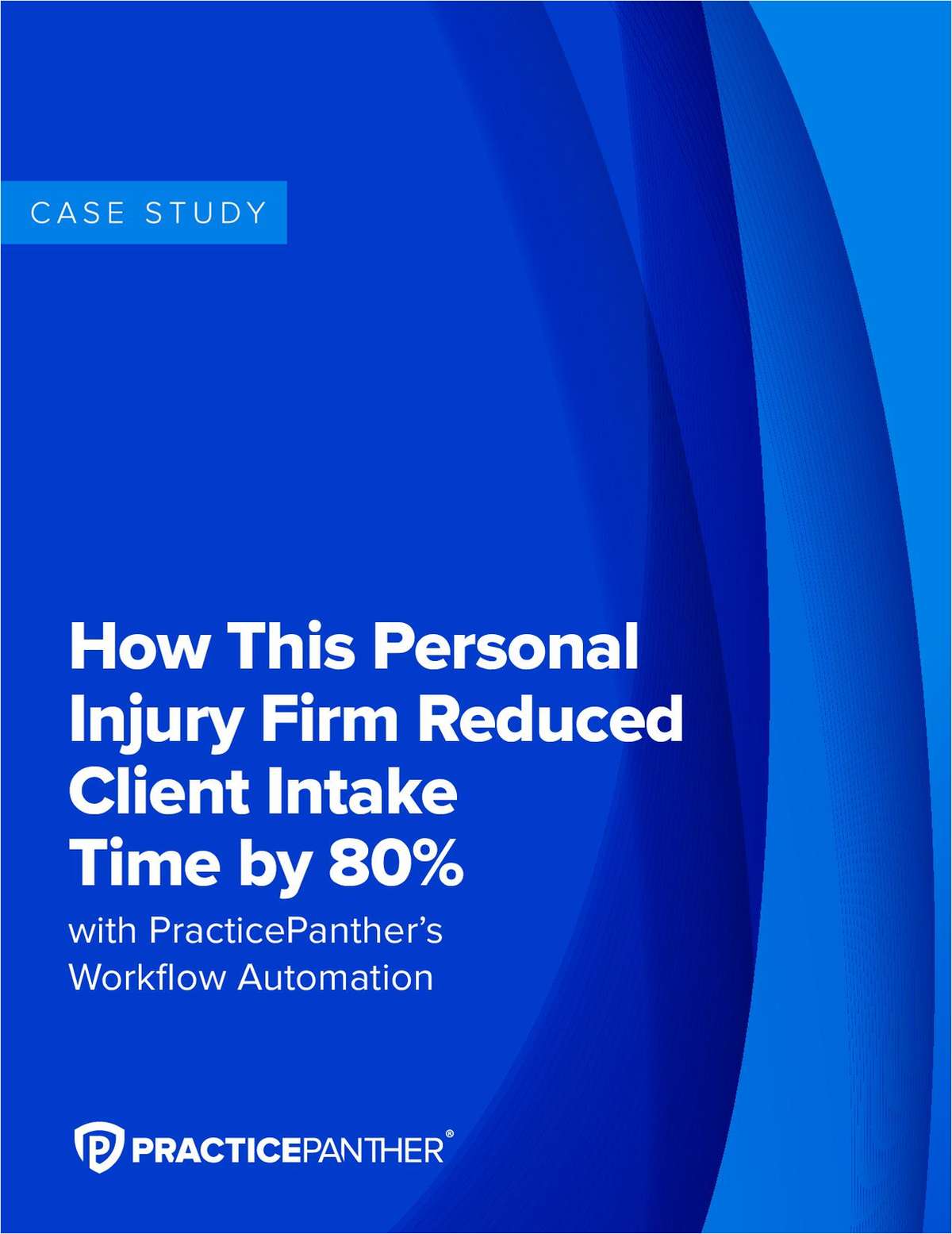Supreme Court Rules Rejection of Trademark License Does Not Rescind Rights of Licensee
<b><i>Mission Product Holdings, Inc. v. Tempnology, LLC</b></i><p> The question for the Court was whether a debtor’s rejection of its agreement granting a license “terminates rights of the licensee that would survive the licensor’s breach under applicable nonbankruptcy law.”
August 20, 2019 at 03:47 PM
18 minute read
This article appeared in The Bankruptcy Strategist, featuring the strategies and techniques devised by the country’s top bankruptcy lawyers and reports on innovative procedural techniques, legislative developments and recent judicial rulings — plus what they mean for you and your clients.
In Mission Product Holdings, Inc. v. Tempnology, LLC, 139 S. Ct. 1652 (2019), the Supreme Court undertakes to resolve a circuit split between the First and Seventh Circuits over the effect of rejection in bankruptcy of a trademark license under section 365 of the Bankruptcy Code. The question is whether a debtor’s rejection of its agreement granting a license “terminates rights of the licensee that would survive the licensor’s breach under applicable nonbankruptcy law.” (Pet. for Cert. i.) Those rights include the right to continue to use the trademarks for the term of the rejected agreement.
Refusing to treat a trademark license agreement any differently from any other executory contract, the Court applies general executory contract principles to resolve the question. It broadly concludes “rejection breaches a contract but does not rescind it. And that means all the rights that would ordinarily survive a contract breach, including those conveyed here, remain in place.” Id. at 1657. Accordingly, the Court holds rejection does not rescind rights the contract previously granted and so cannot revoke the trademark license granted the nondebtor licensee. Id. at 1666.
In reaching this decision, the Court not only resolves the circuit split and an important trademark license issue, but also provides definitive guidance on the effect of rejection. Although rejection is a simple concept, its effect, especially in contracts where the debtor granted valuable property rights, has confused bankruptcy litigants and courts for the last 40 years, ever since the Code was first enacted in 1978. But the Court has now made clear that rejection is a breach, and only a breach. Rejection does not rescind the contract. The counterparty’s rights are not terminated by rejection and are governed by how nonbankruptcy law treats breached contracts, subject to any claims of the counterparty under the contract being treated only as general unsecured claims in the debtor’s bankruptcy.
|Background to Circuit Split
The First and Seventh Circuits split over whether rejection of a trademark license terminates the licensee’s rights to use the trademarks after rejection. Section 365(a) of the Bankruptcy Code allows a debtor to “assume or reject any executory contract,” subject to court approval. Section 365(g) addresses the effect of rejection. It provides only that rejection of an executory contract “constitutes a breach of such contract.” And it further deems that breach to occur “immediately before the filing of the [bankruptcy] petition,” which means any rejection damages claim is treated as a prepetition claim.
The circuit split had its beginnings in Lubrizol Enterprises, Inc. v. Richmond Metal Finishers, Inc., 756 F.2d 1043 (4th Cir. 1985). There, the Fourth Circuit held that rejection of a licensing technology agreement terminates the licensee’s contract rights to the technology, even if outside bankruptcy the licensee would be able to retain those rights after the licensor’s breach. Based on its reading of congressional intent and legislative history, the court determined the “statutory” breach of §365(g) limits the licensee to only a money damages remedy. Id. at 1048.
Congress responded to Lubrizol three years later, enacting §365(n) of the Bankruptcy Code to ensure the licensee of intellectual property can retain its contract rights to intellectual property after rejection of the underlying contract. But Congress excluded trademarks from the intellectual property covered by §365(n). It explained it did so to allow further study of issues peculiar to trademarks and cautioned no inference should be drawn about treatment of executory contracts not related to intellectual property. S. Rep. No. 100-505, 100th Cong., 2d Sess. 5, reprinted in 1988 U.S.C.C.A.N. 3200, 3204.
Since §365(n) does not cover trademarks, Lubrizol remained good law in the Fourth Circuit, governing the effect of rejection of trademark licenses. And, most lower courts drew on the omission of trademarks from §365(n) to reason by negative inference that Lubrizol is intended to control, and so trademark licensees have no contract rights to the trademarks after rejection. E.g., In re Old Carco LLC, 406 B.R. 180, 211 (Bankr. S.D.N.Y. 2009); In re Dynamic Tooling Sys., Inc., 349 B.R. 847, 856 (Bankr. D. Kan. 2006); In re HQ Global Holdings, Inc., 290 B.R. 507, 513 (Bankr. D. Del. 2003).
|Seventh Circuit Sunbeam Decision
The Seventh Circuit rejected that reasoning in Sunbeam Products, Inc. v. Chicago American Manufacturing, LLC, 686 F.3d 372, 375 (7th Cir. 2012), explaining “an omission is just an omission” and “does not affect trademarks one way or the other.” Instead, the court held that rejection does not deprive a trademark licensee of its rights to the trademark under the rejected contract.
Rejecting Lubrizol, the Seventh Circuit explained that “[w]hat §365(g) does by classifying rejection as breach is establish that in bankruptcy, as outside of it, the other party’s rights remain in place.” Id. at 377. Rejection serves only to relieve the debtor from having to perform its contract obligations, converting them to money damages. Since outside bankruptcy a licensor’s breach does not terminate a licensee’s rights to use trademarks, rejection does not have that effect either. Id. at 376-77; see also, In re Exide Techs., 607 F.3d 957, 965-67 (3d Cir. 2010) (Ambro, J., concurring) (reaching similar conclusions and maintaining lower courts should have used equitable powers to give debtor fresh start without stripping licensee of trademark rights).
|First Circuit Tempnology Decision
In In re Tempnology, LLC, 879 F.3d 389 (1st Cir. 2018), rev’d, 139 S. Ct. 1652 (2019), the First Circuit disagreed with the Seventh Circuit and held the licensee does not retain the right to use trademarks after the debtor rejects their trademark license agreement. Judge Torruella disagreed in dissent and would have taken an approach similar to Sunbeam and the concurrence in Exide. Id. at 405-07.
Debtor Tempnology LLC manufactured clothing and accessories designed to stay cool during exercise and marketed them under Coolcare and Dr. Cool brands, using trademarks to distinguish its gear. In 2012, Tempnology and Mission Products Holdings, Inc. entered into a contract granting Mission product distribution rights and licenses including trademark licenses.
After two years of losses, Tempnology filed a Chapter 11 bankruptcy and moved to reject the contract with Mission, blaming Mission and the contract for its demise. The bankruptcy court granted rejection, and Tempnology sought a declaratory judgment rejection terminated the rights granted Mission to use its trademarks.
The bankruptcy court relied on the negative inference from the omission of trademarks from §365(n) to hold Mission did not retain rights to the trademarks after rejection. 541 B.R. 1, 7-8 (Bankr. D.N.H. 2015). Reversing, the bankruptcy appellate panel adopted the rationale of Sunbeam to hold that Mission retained rights in the trademarks after rejection, and those rights were governed by the terms of the licensing agreement and nonbankruptcy law. 559 B.R. 809, 822-23 (1st Cir BAP 2016). The First Circuit reversed the panel and reinstated the bankruptcy court decision terminating Mission’s rights to the trademarks.
The First Circuit first endorsed but did not rely on the negative inference argument. 879 F.3d at 401. The court then, in response to Sunbeam and following Lubrizol, explained that rejection does not terminate the licensee’s contract rights; rather, it converts those rights, without exception, into a prepetition claim for damages. Id.at 402.
But the linchpin of the decision is the First Circuit’s conclusion that the licensee cannot be allowed to retain trademark rights after rejection because of the ongoing obligations imposed by trademark law. Trademark law requires the trademark owner to monitor and control the quality of goods sold under the trademarks, or risk losing the trademarks. For the court, this aspect of trademark law completely undermined the “unstated premise” of Sunbeam, that the debtor could be freed from continuing performance obligations while the licensee’s right to use the trademarks was preserved. Since the principal aim of Congress in providing for rejection was to relieve the debtor of burdensome obligations, rejection of a trademark license should end the licensee’s trademark rights and so relieve the debtor from the ongoing burden of monitoring and controlling the trademark’s use. Id. at 402-04.
|Supreme Court Reverses First Circuit
The Supreme Court reversed the First Circuit in an 8-1 decision, taking an approach similar to the Seventh Circuit’s in Sunbeam. Before the Court, it was common ground that rejection meant: 1) debtor Tempnology could stop performing under the contract; and 2) Mission could assert a general unsecured claim in the bankruptcy for damages from Tempnology’s nonperformance. But the parties disagreed on whether rejection terminated the contract rights Tempnology granted Mission to use its trademarks. 139 S. Ct. at 1659.
In an opinion authored by Justice Kagan, the Court, as it did in NLRB v. Bildisco & Bildisco, 465 U.S. 513, 522 n.6 (1984), defined a contract as executory “if performance remains due to some extent on both sides.” 139 S. Ct. at 1658. (To date, the Court never has adopted or applied the Countryman “material breach” definition of executory contract employed by many lower courts. E.g., In re Interstate Bakeries Corp., 751 F.3d 955, 962 (8th Cir. 2014) (en banc); Exide, 607 F.3d at 962 & n.2.)
|The Issue
According to the Court, the parties and the courts of appeal presented it with two “starkly different” views of the effect of rejection. “According to one view, a rejection has the same consequence as a contract breach outside bankruptcy: It gives the counterparty a claim for damages, while leaving intact the rights the counterparty has received under the contract.” 139 S. Ct. at 1661. According to the other, rejection “has more the effect of a contract rescission in the non-bankruptcy world: Though also allowing a damages claim, the rejection terminates the whole agreement along with all rights it conferred.” Id.
The Court emphatically chose the former. “Rejection of a contract — any contract — in bankruptcy operates not as a rescission but as a breach.” Id. The Court rests its decision on §365’s text and fundamental bankruptcy principles.
|Text of §365(g)
Section 365(g) specifies that rejection “constitutes a breach of contract.” Relying on Field v. Mans, 516 U.S. 59, 69 (1995), the Court concludes breach “is neither a defined nor a specialized bankruptcy term” and “means in the Code what it means in contract law outside bankruptcy.” 139 S. Ct. at 1661.
The Court then looks at the effect of breach outside bankruptcy and determines it provides the non-breaching party the choice between: 1) affirming the contract and continuing to perform; and 2) walking away from the contract and ceasing all performance, and, in both cases, suing for any damages incurred. The Court emphasizes the choice was the non-breaching party’s and not the breaching party’s. Id. at 1662.
The Court reasons that since rejection constitutes a breach, the same result follows in bankruptcy. After rejection, the non-breaching party has the option to “continue the contract or walk away, while suing for whatever damages go with its choice.” Id. Rejection does not terminate the contract. The debtor and its counterparty do not go back to their pre-contract positions. Instead, the counterparty retains the rights it has received under the contract. “As after a breach, so too after a rejection, those rights survive.” Id.
The Court explains the same applies to rejected trademark licenses. Outside bankruptcy, breach does not revoke the license or stop the licensee from doing what it allows. So, in bankruptcy, while after rejection the debtor can stop performing its obligations, it cannot rescind the license already conveyed. The “licensee can continue to do whatever the license authorizes.” Id. at 1662-63.
|Fundamental Bankruptcy Principles
In further support, the Court relies on the rule of Board of Trade of Chicago v. Johnson, 264 U.S. 1 (1924), that the “estate cannot possess anything more than the debtor itself did outside bankruptcy.” 139 S. Ct. at 1663. So the debtor is subject to the same contractual rights of its counterparty in bankruptcy as outside bankruptcy. “By insisting that the same counterparty rights survive rejection as survive breach, the rule prevents a debtor in bankruptcy from recapturing interests it had given up.” Id.
The Court also explains that allowing rejection to function as rescission would circumvent the Code’s stringent limits on avoidance actions, particularly those placed on the power to avoid fraudulent transfers. If debtors can use rejection to rescind the grant of interests, rejection would become functionally equivalent to avoidance, but without the limitations placed on invoking the avoidance powers. “And that result would subvert everything the Code does to keep avoidances cabined — so they do not threaten the rule that the estate can take only what the debtor possessed before filing.” Id. So, the Court concludes “core tenets of bankruptcy law push in the same direction as Section 365’s text: Rejection is breach, and has only its consequences.” Id.
|Rejection of Tempnology’s Arguments
The Court rejected both Tempnology’s main argument resting on a negative inference and its secondary argument based on the impact of special features of trademark law. Tempnology’s main argument is based on the negative inference it draws from discrete amendments to §365 allowing the debtor’s counterparty to continue to exercise contract rights after rejection. See, 11 U.S.C. §§365(h) (real property leases and timeshare interests), (i) (real property sale contracts), (n) (certain intellectual property). From these provisions’ enactment, Tempnology draws the negative inference the ordinary consequence of rejection must be to terminate previously granted contract rights. Otherwise, there would have been no need for the amendments. Id. at 1663-64.
The Court rejects this argument because it attaches too much weight to subsidiary provisions of §365 and not enough to the main ones governing rejection generally. The argument fails to account for how the “breach” specified in §365(g) can be read to mean “rescission,” which is not a consequence of breach. At the same time, the argument fails to recognize that those amendments to §365 were uncoordinated. Each was made at different time over half a century and “responded to a discrete problem — as often as not, correcting a judicial ruling of just the kind Tempnology urges.” Id. at 1664. The Court concludes “this mash-up of legislative interventions says nothing much about the content of Section 365(g)’s general rule.” Id. The Court also notes the amendments are not redundant of §365(g), since each alters the ordinary remedial scheme for breach in some respect. Id. n.2.
Examining Congress’s enactment of §365(n) in response to Lubrizol, the Court makes the point “Congress’s repudiation of Lubrizol for patent contracts does not show any intent to ratify that decision’s approach for almost all others. Which is to say that no negative inference arises.” Id. at 1664-65. This leads the Court to conclude “Congress did nothing in adding Section 365(n) to alter the natural reading of Section 365(g) — that rejection and breach have the same results.” Id. at 1665.
The Court also rejects Tempnology’s subsidiary argument that rejection should terminate the trademark license to relieve the debtor of the obligations imposed by trademark law to monitor and control the quality of goods sold under the trademark. The Court points out that this argument is specific to trademark licenses and supplies no support for a construction of §365 meant to be applicable to all executory contracts. Nor does §365 contain any trademark specific rule. Id.
Although the Court acknowledges that leaving in place obligations imposed by trademark law might impede some reorganizations, it explains that Congress struck a balance in the Bankruptcy Code between the interest of the debtors and the interests of others, and did not intend to remove all obstacles to reorganization. The Court emphasizes §365 provides the debtor a powerful tool, allowing it to escape all of its future contract obligations in exchange for very little. But §365 does not exempt the debtor from complying with generally applicable law like contract or trademark law, or relieve it from having to make business decisions like whether to invest the resources needed to maintain trademarks. While the balance struck by Congress might impede some reorganizations, “that is only to say that Section 365’s edict that rejection is breach expresses a more complex set of aims than Tempnology acknowledges.” Id. at 1665-66.
|Justice Sotomayor’s Concurrence
Justice Sotomayor joined the Court’s opinion in full but wrote separately to make two helpful points. First, while the Court held that rejection does not terminate rights of a licensee that would survive the licensor’s breach under applicable law, “the baseline inquiry remains whether the licensee’s rights would survive a breach under applicable law,” and that question could be affected by the contract terms or state law. Id. at 1666. Second, since trademarks are not covered by §365(n), the postrejection rights and remedies of trademark licensees are more expansive than those of licensees of patents, copyrights, and other intellectual property covered by that statute. Justice Sotomayor agrees with the Court that this is no basis for construing §365(g) differently for trademark licenses and concludes by observing Congress has the option of tailoring a provision for trademark licenses. Id. at 1666-67.
|Justice Gorsuch’s Dissent
Justice Gorsuch was the lone dissenter. He would have dismissed the petition as improvidently granted. He thought it far too uncertain whether Mission had a viable damages claim sufficient to keep the case from being moot. Id. at 1667. The Court held the case was not moot because Mission did have a viable damages claim. Id. at 1660-61. See also, Tempnology, 879 F.3d at 397 (at issue was proper priority under the Bankruptcy Code to accord any damages claim of Mission).
|Impact of Supreme Court’s Holding
Although the particular executory contract before the Court was a trademark license, the Court did not limit its holding to trademark licenses. Instead, its decision is applicable to all executory contracts limited only by discrete provisions of §365 addressing particular types of executory contracts. As a result, the effect of the breach of contract resulting from rejection will remain to be determined by applying applicable nonbankruptcy law.
In most cases, this will present few issues. For example, suppose a debtor has contracted before bankruptcy to sell its counterparty certain goods, but files bankruptcy before performance is due. The debtor decides the price for the goods is below market and so rejects the parties’ contract. The counterparty will have only an unsecured claim for breach of contract damages from the debtor’s rejection of the contract. The only issue will be how much those damages are.
It will mainly be in contracts like the distribution agreement between Tempnology and Mission, where the debtor has conveyed rights and interests to its counterparty and the parties have an ongoing contractual relationship, that the effect of rejection may be difficult to determine. This issue with respect to trademark licenses is discussed at some length in the Brief of American Intellectual Property Law Association as Amicus Curiae at 20-27. (Part of that discussion is cited by Justice Sotomayor, 139 S. Ct. at 1666.)
It also remains to be seen whether the Supreme Court’s holding will subsume those discrete provisions of §365 ensuring rejection will not terminate the debtor’s counterparties’ rights under the contract. Those provisions are by their terms permissive but impose certain restrictions on the counterparty that nonbrankruptcy law typically does not. See, 11 U.S.C. §§365(h), (i), (n); Tempnology, 139 S. Ct. at 1664 n.2. For example, §365(n) provides that the licensee “may elect” to invoke its protections. But the statute imposes a price for doing so. The licensee must make all royalty payments due under the contract and is deemed to waive any right of setoff and any administrative claim related to the contract. 11 U.S.C. §365(n)(2); see, e.g., In re CellNet Data Sys., Inc., 327 F.3d 242 (3d Cir. 2003); In re Prize Frize, Inc., 32 F.3d 426 (9th Cir. 1994). Both the majority and concurring opinions in Tempnology suggest these limitations do not apply to trademark licensees. 139 S. Ct at 1663-65 & n.2; id. at 1666-67 (Sotomayor, J., concurring). May licensees of intellectual property decide to forego the §365(n) election in favor of relying on the general §365(g) provision and thereby avoid the restrictions of §365(n)(2)?
But despite the open issues, the Supreme Court’s ruling has narrowed the inquiry to nonbankruptcy law whereas before the ruling the parties faced the additional uncertainty of whether rejection itself would terminate or leave intact the counterparty’s rights and interests. Now, the debtor and purchasers of its assets will know that rejection does not terminate the counterparty’s rights and interests and that nonbankruptcy law will determine whether the counterparty the debtor’s counterparties will retain its rights and interests, and if retained, how they will be treated after rejection of the underlying contract.
*****
Mark W. Page is of counsel at Massey & Gail LLP in Chicago. He may be reached at [email protected] or 312-379-0720.
This content has been archived. It is available through our partners, LexisNexis® and Bloomberg Law.
To view this content, please continue to their sites.
Not a Lexis Subscriber?
Subscribe Now
Not a Bloomberg Law Subscriber?
Subscribe Now
NOT FOR REPRINT
© 2024 ALM Global, LLC, All Rights Reserved. Request academic re-use from www.copyright.com. All other uses, submit a request to [email protected]. For more information visit Asset & Logo Licensing.
You Might Like
View All
A Look Back at High-Profile Hires in Big Law From Federal Government
4 minute read
'Appropriate Relief'?: Google Offers Remedy Concessions in DOJ Antitrust Fight
4 minute read
Life, Liberty, and the Pursuit of Customers: Developments on ‘Conquesting’ from the Ninth Circuit
8 minute read
Legal Departments Gripe About Outside Counsel but Rarely Talk to Them
4 minute readTrending Stories
- 1Decision of the Day: Judge Reduces $287M Jury Verdict Against Harley-Davidson in Wrongful Death Suit
- 2Kirkland to Covington: 2024's International Chart Toppers and Award Winners
- 3Decision of the Day: Judge Denies Summary Judgment Motions in Suit by Runner Injured in Brooklyn Bridge Park
- 4KISS, Profit Motive and Foreign Currency Contracts
- 512 Days of … Web Analytics
Who Got The Work
Michael G. Bongiorno, Andrew Scott Dulberg and Elizabeth E. Driscoll from Wilmer Cutler Pickering Hale and Dorr have stepped in to represent Symbotic Inc., an A.I.-enabled technology platform that focuses on increasing supply chain efficiency, and other defendants in a pending shareholder derivative lawsuit. The case, filed Oct. 2 in Massachusetts District Court by the Brown Law Firm on behalf of Stephen Austen, accuses certain officers and directors of misleading investors in regard to Symbotic's potential for margin growth by failing to disclose that the company was not equipped to timely deploy its systems or manage expenses through project delays. The case, assigned to U.S. District Judge Nathaniel M. Gorton, is 1:24-cv-12522, Austen v. Cohen et al.
Who Got The Work
Edmund Polubinski and Marie Killmond of Davis Polk & Wardwell have entered appearances for data platform software development company MongoDB and other defendants in a pending shareholder derivative lawsuit. The action, filed Oct. 7 in New York Southern District Court by the Brown Law Firm, accuses the company's directors and/or officers of falsely expressing confidence in the company’s restructuring of its sales incentive plan and downplaying the severity of decreases in its upfront commitments. The case is 1:24-cv-07594, Roy v. Ittycheria et al.
Who Got The Work
Amy O. Bruchs and Kurt F. Ellison of Michael Best & Friedrich have entered appearances for Epic Systems Corp. in a pending employment discrimination lawsuit. The suit was filed Sept. 7 in Wisconsin Western District Court by Levine Eisberner LLC and Siri & Glimstad on behalf of a project manager who claims that he was wrongfully terminated after applying for a religious exemption to the defendant's COVID-19 vaccine mandate. The case, assigned to U.S. Magistrate Judge Anita Marie Boor, is 3:24-cv-00630, Secker, Nathan v. Epic Systems Corporation.
Who Got The Work
David X. Sullivan, Thomas J. Finn and Gregory A. Hall from McCarter & English have entered appearances for Sunrun Installation Services in a pending civil rights lawsuit. The complaint was filed Sept. 4 in Connecticut District Court by attorney Robert M. Berke on behalf of former employee George Edward Steins, who was arrested and charged with employing an unregistered home improvement salesperson. The complaint alleges that had Sunrun informed the Connecticut Department of Consumer Protection that the plaintiff's employment had ended in 2017 and that he no longer held Sunrun's home improvement contractor license, he would not have been hit with charges, which were dismissed in May 2024. The case, assigned to U.S. District Judge Jeffrey A. Meyer, is 3:24-cv-01423, Steins v. Sunrun, Inc. et al.
Who Got The Work
Greenberg Traurig shareholder Joshua L. Raskin has entered an appearance for boohoo.com UK Ltd. in a pending patent infringement lawsuit. The suit, filed Sept. 3 in Texas Eastern District Court by Rozier Hardt McDonough on behalf of Alto Dynamics, asserts five patents related to an online shopping platform. The case, assigned to U.S. District Judge Rodney Gilstrap, is 2:24-cv-00719, Alto Dynamics, LLC v. boohoo.com UK Limited.
Featured Firms
Law Offices of Gary Martin Hays & Associates, P.C.
(470) 294-1674
Law Offices of Mark E. Salomone
(857) 444-6468
Smith & Hassler
(713) 739-1250








